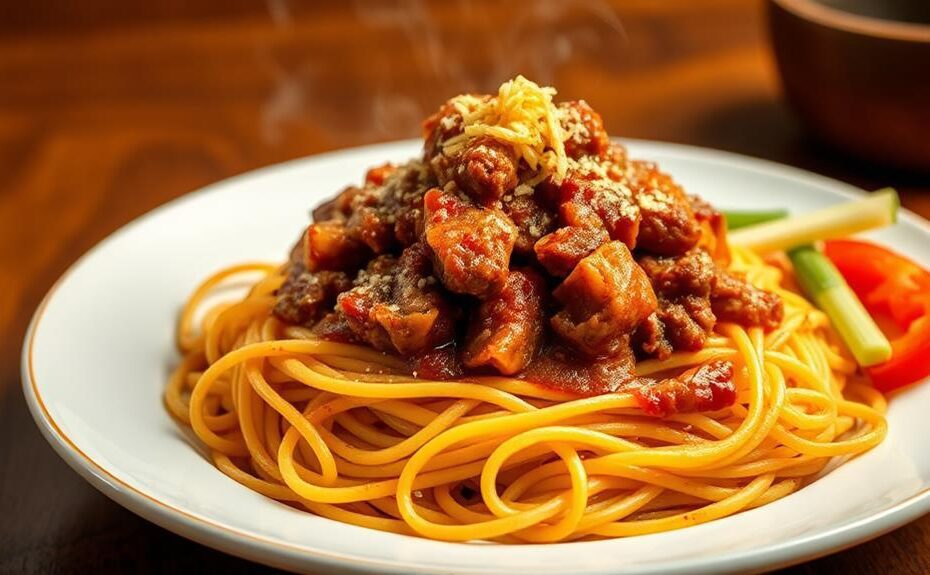Pinoy-style spaghetti has a distinct flavor profile that sets it apart from traditional spaghetti.
This unique taste is attributed to the incorporation of sugar and banana ketchup in the sauce, which adds a sweet element to the dish. The savory aspect comes from the use of ground beef or pork and red hot dogs, creating a flavor combination unlike any other.
The creamy sauce, made with evaporated milk, coats the tongue and provides a rich, thick texture that is often associated with childhood celebrations and family gatherings.
The Filipino twist on this classic dish is a result of cultural influences and adaptations.
In the Philippines, spaghetti is often served with a sweet-style sauce, which is a departure from the traditional Italian tomato sauce. This adaptation is a result of the country's cultural history, with influences from Spanish, American, and Asian cuisines.
As a result, Pinoy-style spaghetti has become a beloved comfort food in the Philippines, with its own unique characteristics and flavor profile.
Filipino Spaghetti's Sweet Twist
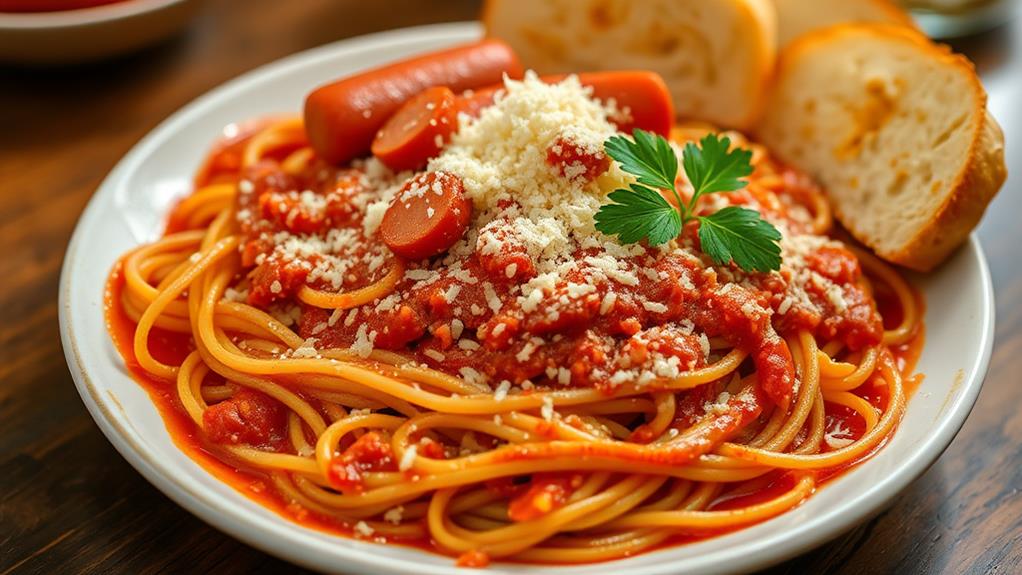
Filipino Spaghetti's Unique Flavor Profile
Filipino spaghetti stands out from traditional Italian spaghetti due to its distinct sweetness. This sweetness comes from adding sugar and banana ketchup to the sauce, giving it a uniquely Filipino flavor profile.
The sauce is a combination of sweet tomato sauce and evaporated milk, which adds creaminess and balances the acidity of the tomatoes. This creamy sauce is a key factor in Filipino spaghetti's appeal.
Filipino spaghetti is a staple at birthday parties and family gatherings, particularly among kids. The addition of sweeter red hot dogs enhances the overall sweetness of the dish.
A sprinkle of quick-melting cheese adds richness and a creamy texture, complementing the sweet sauce. This combination of flavors and textures makes Filipino spaghetti a comfort food that's hard to resist.
Filipino spaghetti's unique flavor profile sets it apart from other versions of spaghetti. Its sweetness, creaminess, and rich texture have made it a beloved favorite in many Filipino households.
Cultural Significance and Origins
The cultural significance of Filipino spaghetti lies in its ability to evoke nostalgia and connection to heritage, transporting individuals back to childhood celebrations and family gatherings.
American influence played a significant role in the origin of Filipino spaghetti, as hot dogs and ketchup were introduced to Filipino cuisine during the American colonization period. This introduction led to the creation of a unique fusion dish.
Filipino spaghetti's sweet and sticky sauce, featuring banana ketchup, was developed during World War II due to tomato scarcity. This adaptation showcases the resourcefulness of Filipino cuisine.
Filipino spaghetti represents a fusion of traditions, merging Italian influences with local flavors and ingredients. This blending of culinary traditions illustrates the evolution of Filipino cuisine.
For instance, the use of banana ketchup and sweet-style sauce reflects the Filipino preference for sweet flavors.
This iconic dish has become an integral part of Filipino celebrations, and its vibrant color and sweetness are culturally associated with deliciousness.
As a comfort food, Filipino spaghetti evokes nostalgia and connection to heritage.
Unique Ingredients and Flavors
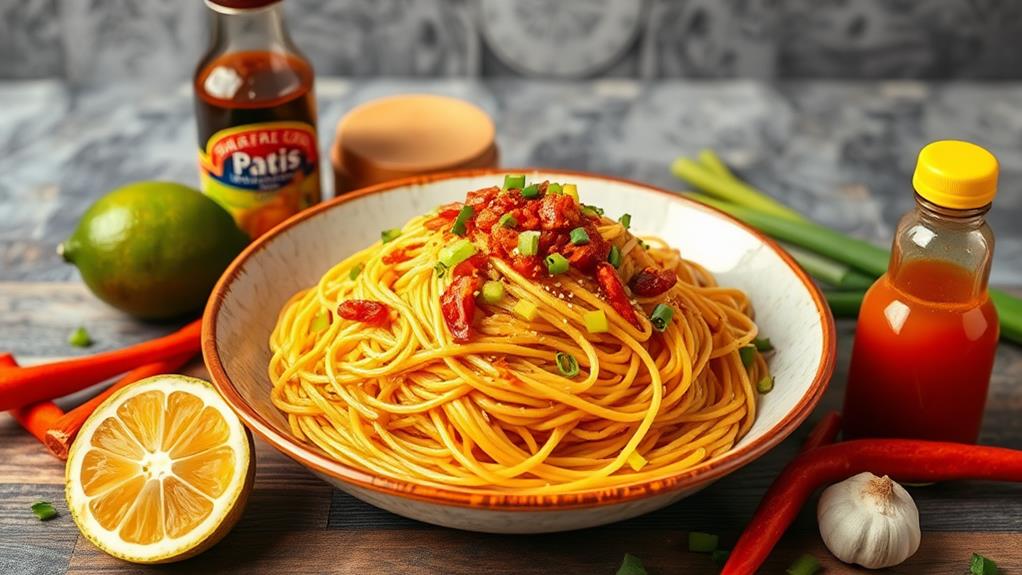
Filipino spaghetti's unique flavor profile is shaped by the country's cultural diversity. This is evident in the use of banana ketchup, a staple in Filipino cuisine, which adds a sweet and fruity twist to the traditional tomato sauce.
The inclusion of red hot dogs, a common ingredient in Filipino food, adds a vibrant red color and a distinct flavor that sets it apart from its Italian counterpart.
The sauce is a masterful blend of ingredients, resulting in a sweet, tangy, and savory flavor profile. This is achieved by combining ground pork, sweet tomato, and sugar.
The use of quick-melting cheese, such as Velveeta or local brands, adds a creamy texture and richness to the dish. Overall, Filipino spaghetti is a reflection of the country's ability to fuse local tastes with foreign influences.
Cooking Techniques and Tips
Crafting the Perfect Pinoy-Style Spaghetti
To achieve a mouthwatering Pinoy-style spaghetti, mastering essential cooking techniques and tips is crucial. This beloved dish requires more than just combining ingredients; it demands a thoughtful approach to bring out its full flavor potential.
Building a Flavorful Base
To start, sauté onions and garlic in oil to create a rich foundation for the dish. This step is crucial in developing the overall flavor profile.
Then, add ground meat and other ingredients to the pan, ensuring they're properly browned and cooked through.
Simmering the Sauce
Simmering the sauce for at least 30 minutes is vital to allow the flavors to meld together, resulting in a rich and thick sauce that complements the spaghetti.
This step ensures the sauce is neither too watery nor too overpowering.
Elevating the Dish
To take your Pinoy-style spaghetti to the next level, follow these three crucial tips:
Balance the Acidity: Add evaporated milk towards the end of cooking to balance the acidity of the tomato sauce and enhance creaminess.
Sweeten to Taste: Add sugar to the sauce to adjust to personal taste preferences, as Filipino spaghetti is distinctly sweeter than its Italian counterpart.
Get the Texture Right: Avoid rinsing the cooked spaghetti, and consider reserving some pasta water to adjust sauce consistency if it becomes too thick.
Nostalgic Value and Memories
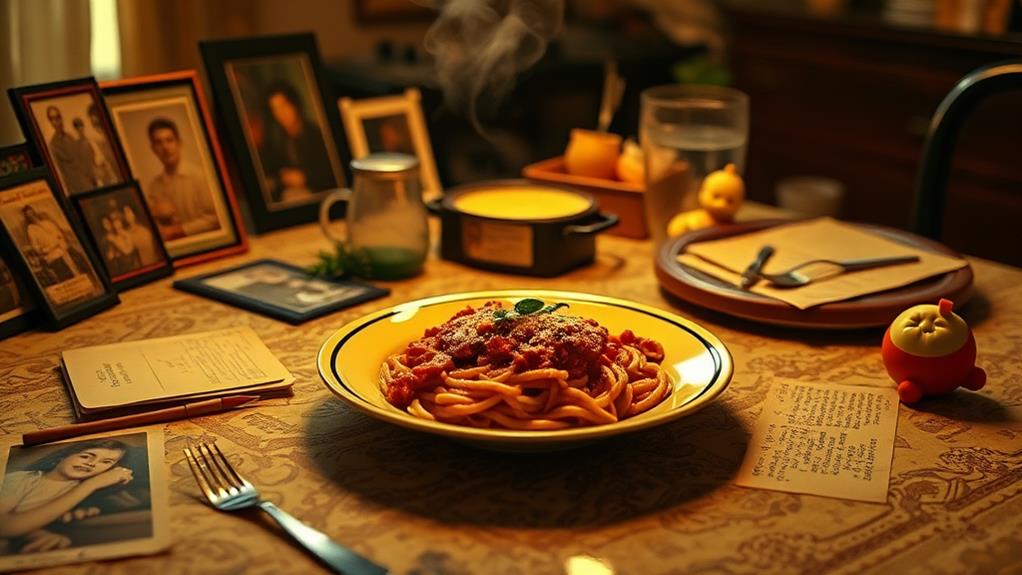
Filipino Spaghetti: A Nostalgic Comfort Food
Filipino Spaghetti evokes memories of childhood celebrations and family gatherings. This dish is more than just a meal; it's a nostalgic comfort food that transports you back to a time when life was simpler and birthday parties were the highlight of your year.
The vibrant red color of the sweet sauce instantly brings back images of joyful Filipino gatherings. These gatherings were filled with laughter and love, where family and friends came together to celebrate special occasions.
The addition of hot dogs, a unique twist to the classic spaghetti, sparks conversations about childhood memories and cherished dining experiences.
Filipino Spaghetti is a staple in many Filipino households, reminding you of the importance of family celebrations and cultural traditions. It's often served alongside other classic Filipino dishes, such as fried chicken and cake, at birthday parties and special events.
The dish holds a special place in many hearts, symbolizing the simplicity and joy of childhood.
Adaptation and Evolution
Filipino Spaghetti's uniqueness stems from creative adaptations that shaped its evolution. This beloved dish wasn't always a staple in Filipino cuisine, having evolved from traditional Italian recipes by incorporating local ingredients.
The Filipino palate prefers sweeter sauces. To cater to this taste preference, sugar was introduced in the cooking process, setting Filipino spaghetti apart from its Italian counterpart. This adaptation reflected the local palate's distinct characteristic.
Local ingredients became staples. The addition of hot dogs and banana ketchup, particularly during American colonization in the late 1800s, became integral to Filipino cuisine. These ingredients were incorporated into the spaghetti dish to suit local tastes.
Fast-food chains further popularized Filipino spaghetti. The rise of fast-food chains like Jollibee, which introduced its own version, Jolly Spaghetti, contributed to the dish's widespread popularity and cultural significance in the country.
This fusion of flavors not only made Filipino spaghetti unique but also cemented its cultural importance.
Key Ingredients and Variations
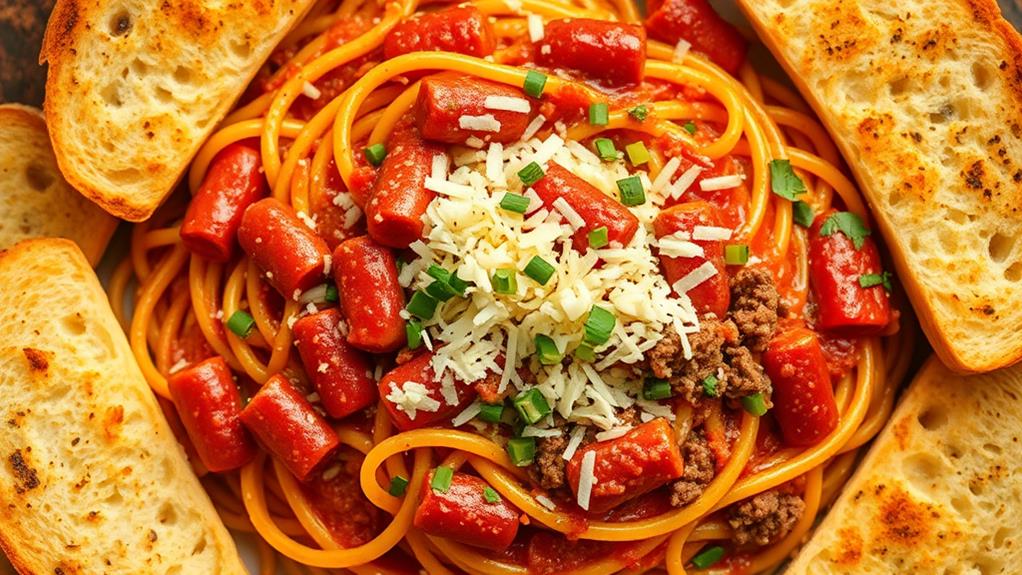
What sets Spaghetti Pinoy Style apart is its unique combination of ingredients and variations.
Spaghetti Pinoy Style is a dish that explodes with flavor, thanks to its key ingredients. The sweetness of banana ketchup, a unique ingredient developed during World War II, is balanced by the savory flavor of Filipino-style red hot dogs. The evaporated milk adds a rich and creamy texture to the sauce, balancing out the acidity.
Three key ingredients make this dish special:
| Ingredient | Description |
|---|---|
| Banana Ketchup | Adds sweetness and tanginess to the sauce |
| Filipino-style Red Hot Dogs | Contributes a distinct flavor and vibrant color |
| Evaporated Milk | Balances acidity and enhances creaminess |
Some recipes may vary by using ground pork or beef as the protein base, while others incorporate luncheon meat or Spam for added depth of flavor. Additionally, quick-melting cheese, like Velveeta, is typically used as a topping, providing a creamy finish that complements the sweet sauce. These ingredients come together to create a rich and comforting flavor profile that's uniquely Filipino.
Flavor Profile and Texture
The flavors in Spaghetti Pinoy Style meld together in harmony, creating a truly unique flavor profile that's both familiar and excitingly different.
The sweetness of the dish is amplified by the addition of banana ketchup, which adds a tangy richness. The thick, sticky sauce coats the noodles perfectly, thanks to the simmered meat mixture with tomato sauce and sugar.
Three key elements contribute to the dish's flavor profile and texture:
Sweet and savory contrast is achieved by combining ground beef or pork with red hot dogs, which introduces a savory depth and balances the sweetness of the sauce, creating a mix of sweet, salty, and meaty flavors.
The creamy and comforting aspect comes from quick-melting cheese, which adds a fatty flavor, and evaporated milk, which creates a smooth and comforting mouthfeel, balancing the acidity of the sauce.
The dish's hearty and indulgent quality is due to the thick sauce and rich flavors, making each bite feel indulgent and satisfying, making Spaghetti Pinoy Style a comforting and filling meal.
Serving Suggestions and Pairings
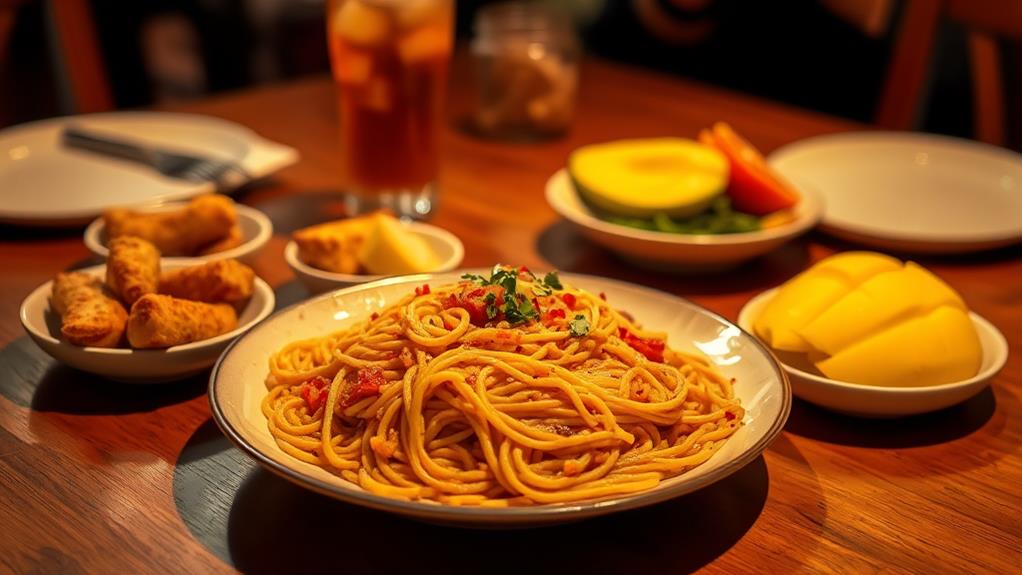
Elevate the Filipino Spaghetti Experience with Traditional Pairings
To fully appreciate the unique flavor profile of Filipino spaghetti, serve it with complementary dishes that balance its sweet and tangy sauce.
Pairing it with fried chicken creates a well-rounded meal, perfect for parties and family gatherings. For added satisfaction, serve it with garlic bread and a refreshing green salad to cut the richness of the sauce.
Add a Creamy Touch with Shredded Quick Melt Cheese
Top the spaghetti with shredded quick melt cheese, which adds a creamy and indulgent layer to the dish. This combination is often served at celebratory meals, making it a staple at birthday parties alongside traditional birthday cakes.
Offer Additional Flavor Options
Provide a side of sweet and sour sauce or banana ketchup to offer an extra layer of flavor, reflecting the unique taste profile of Filipino cuisine.
Can I Make Spaghetti Pinoy Style Without the Secret Ingredient?
Yes, you can definitely make spaghetti Pinoy style without the secret ingredient. The key to perfecting spaghetti pinoy style is to use local Filipino flavors such as banana ketchup, hotdogs, and ground meat. These will give your spaghetti that unique and delicious Filipino twist that everyone will love.
Global Popularity and Reception
Filipino spaghetti's unique flavor profile has captured the hearts and taste buds of people worldwide. Its distinct sweet flavor and cultural significance have gained international recognition.
Cultural connection is a key factor in its global popularity. For Filipinos living abroad, a plate of spaghetti Pinoy style is a comforting reminder of their cultural heritage and childhood memories.
Filipino spaghetti has been successfully adapted into local cuisine in countries like Australia, showcasing its global interest and unique twist on traditional pasta dishes.
Social media has played a significant role in spreading the popularity of Filipino spaghetti. Social media platforms have facilitated the sharing of recipes, creating a community of enthusiasts eager to explore and recreate this beloved dish outside the Philippines.
The combination of sweet sauce and hot dogs often surprises and delights non-Filipino diners, sparking discussions about cultural fusion and the evolution of culinary traditions.
Filipino spaghetti is more than just a dish – it's a symbol of cultural heritage and global interest.
Frequently Asked Questions
How Is Filipino Spaghetti Different?
Filipino spaghetti is distinct from its international counterparts due to its unique blend of regional variations, ingredient choices, and cooking techniques shaped by cultural influences.
It is sweeter due to the addition of sugar and banana ketchup, a popular condiment in the Philippines. This sweetness is a hallmark of Filipino spaghetti and sets it apart from other versions.
Meat is often added, typically in the form of hot dogs or sausages, which are common ingredients in Filipino cuisine. This adds a savory element to the dish.
Filipino spaghetti is a staple at festive occasions and family gatherings, catering to local taste preferences.
Its unique flavor profile has become an integral part of Filipino celebrations and social gatherings.
Why Is Filipino Spaghetti Sauce Sweet?
Filipino spaghetti sauce is sweet because it's deliberately made with sweet ingredients. These ingredients, such as sugar, banana ketchup, and condensed milk, cater to the Filipino taste preference for vibrant flavors.
This cultural preference is influenced by the country's history and cuisine, which combines different flavors and ingredients.
Regional variations and family traditions also play a role in the sweetness of Filipino spaghetti sauce. For example, some popular toppings like grated cheese and hot dogs add to the sweetness.
These toppings are commonly used in Filipino spaghetti dishes, especially during festive occasions.
What Is Filipino Style Spaghetti and Why Is It Named One of the Worst Dishes in the World?
Filipino-style spaghetti is a unique pasta dish shaped by cultural influences from American colonization.
This sweet and savory dish is a product of Filipino history.
The country's colonial past led to the adoption of American food habits, including sweet-style pasta sauces.
Regional variations and ingredient substitutions, such as using banana ketchup and hot dogs, set it apart from traditional Italian recipes.
Despite being considered one of the worst dishes in the world, Filipino-style spaghetti is a beloved comfort food for Filipinos.
It brings joy to family gatherings and festive occasions.
Why Is Pasta Famous in the Philippines?
Pasta's popularity in the Philippines stems from cultural influences that shaped the country's culinary history.
When the Americans colonized the Philippines, they introduced pasta to the Filipino diet. The Filipinos adapted pasta to their taste, which led to unique variations that became regional specialties.
For instance, some pasta dishes use banana ketchup, a sweet and tangy condiment that's a staple in Filipino cuisine.
Pasta has become a staple at Filipino gatherings due to its adaptability to local tastes.
Creative ingredient substitutions have fueled pasta's popularity in the Philippines. For example, some recipes use patis (fish sauce) or bagoong (fermented fish paste) to add flavor to pasta dishes.
This blend of foreign and local flavors has resulted in a unique fusion cuisine that Filipinos have grown to love.
